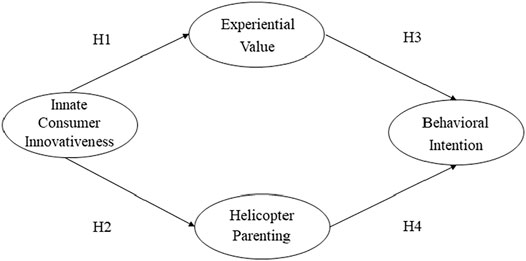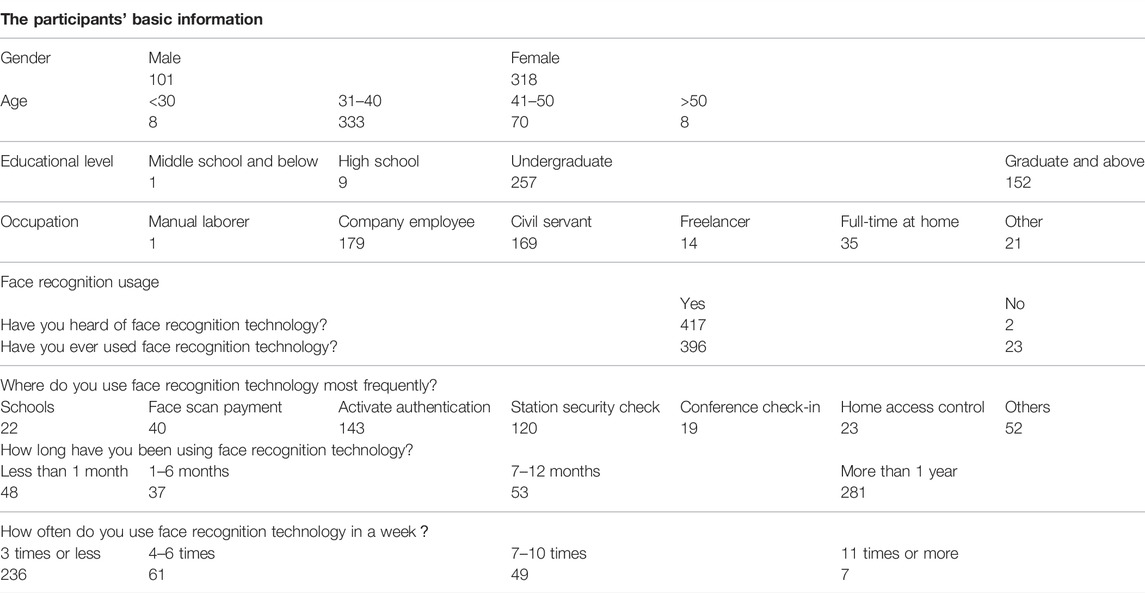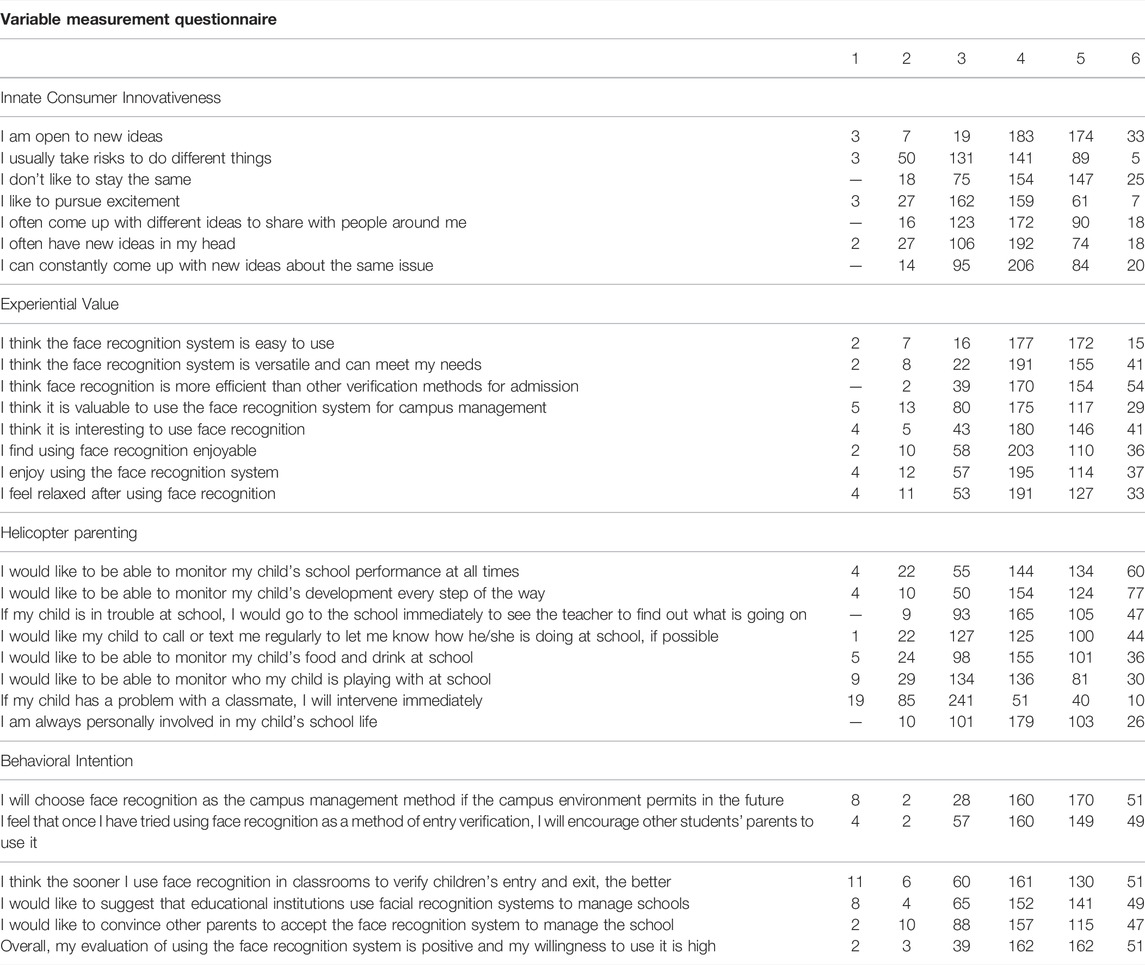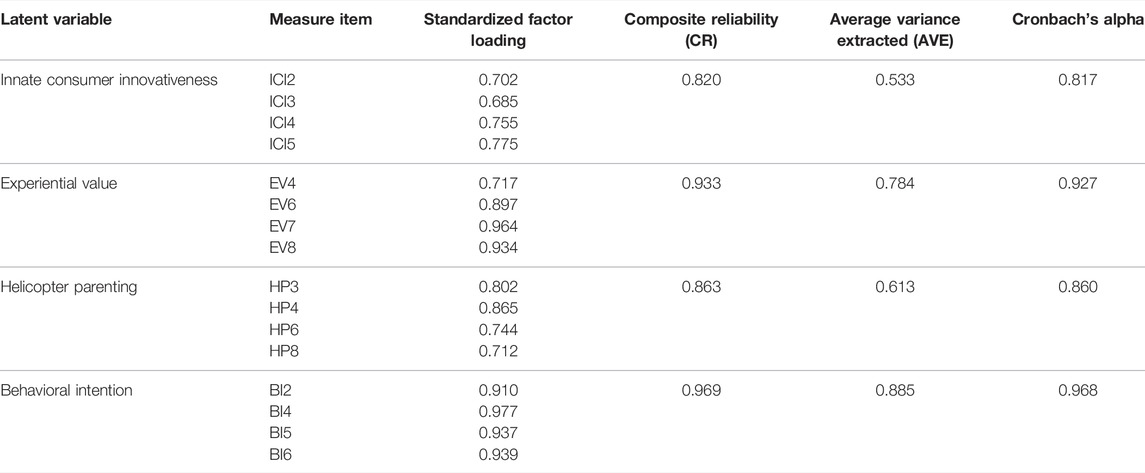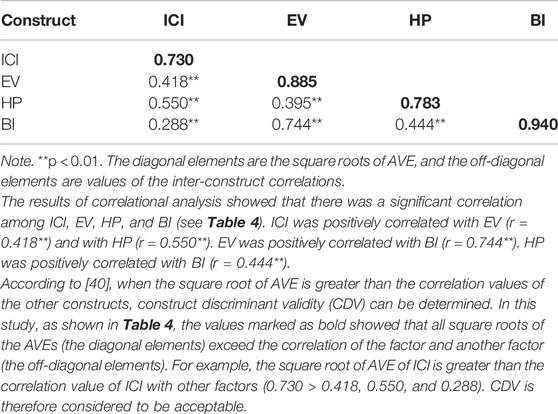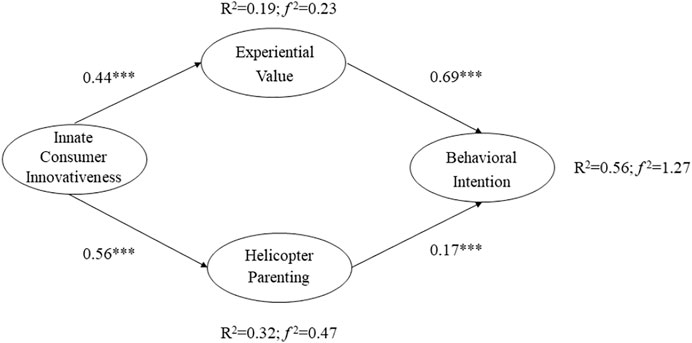- 1School of Education Science, Nanjing Normal University, Nanjing, China
- 2Department of Computer Science and Engineering, National Taiwan Ocean University, Keelung, Taiwan
Face recognition technology (FRT) is being increasingly used to record the trajectory of human behavior due to its non-contact nature and high accuracy. When the technology is extended to education, it is applied to manage students’ access to campus, to analyze learning behaviors, and to monitor students’ campus activities. It is important to note that the use of face recognition technology for students on campus should be approved by the students’ guardians. Therefore, this study aimed to determine what factors affect the behavioral intentions of preschool parents’ adoption of facial recognition systems on campus. Unlike previous studies, the model of this study was designed to focus not only on the affective dimension, but also on the parenting style. The model was validated with data from an online questionnaire completed by 419 preschool parents. AMOS was used to analyze various assumptions of the model. The analysis revealed that innate consumer innovativeness positively influenced experience values and helicopter parenting which directly affected their behavioral intentions. The results imply that in the application of face recognition technology, parents’ behavioral intentions depend not only on the prior experiential value of the product and helicopter parenting, but also on parents’ innate consumer innovativeness. Therefore, for campus management and technology application, this study is useful to understand the behavioral intention of guardians to use the new technology. For operators and users of face recognition technology, this study provides several guidelines for exploring parental attitudes toward child supervision and improving products and services to value information security.
1 Introduction
Analysis of human behavior and its behavioral intentions is a common research method in social science. Technology is not only a tool for innovation in the service of research, but also an element that can facilitate the emergence of innovation in new contexts [1]. Based on the support of deep learning and big data, the speed and accuracy of face recognition technology in analyzing human emotions and states are rapidly improving [2], and its application areas have been extended to education, human-computer interaction, epidemic prevention, and other aspects closely related to our lives [3–5]. However, most of previous studies on face recognition technology have focused on practical applications, such as improving the accuracy and scale of face recognition [6, 7]. In fact, the unique feature of face recognition technology that does not require active human cooperation raises certain security and ethical issues in the application process. Lai et al. [8] summarized some of the controversies and concerns arising from the misuse of face recognition technology. As people become more aware of information data protection, it is necessary to actively explore the factors that influence the use of face recognition technology.
As education and emerging technologies continue to integrate and innovate, there is growing demand for face recognition technology in education [9]. The development of technology in new areas is essential to increase and update existing knowledge [10]. One of the main applications of face recognition technology relies on deep learning for classroom management and monitoring of students’ learning behavior [11]. On a campus or in a classroom, the target of face recognition is students who are not yet adults, and their privacy and facial data should be more effectively protected. Therefore, when face recognition technology is carried out in a classroom or on campus, seeking the behavioral intention of their guardians regarding face recognition technology is a key step in the implementation of the technology. In fact, whether adopting technology or consuming a product, behavioral intentions are influenced by many factors, including both the user’s pre-existing personality traits and prior use experiences. For example, Jing et al. [12] found that parents’ personal traits and innate innovation influence their choice of autonomous vehicles for their children’s safety. In other words, parents’ personal traits and innate innovation tend to directly influence their usage behavior. The importance of user experience value has been widely used in acceptance studies of new technology products, and previous studies have shown that prior emotional and functional experiences have a significant impact on consumer attitudes toward using such products, and will influence consumer choices long into the future [13, 14]. There has, however, been little research on the experiential value of using face recognition systems. In addition, parenting style has become an important consideration when exploring parenting and parental supervision. Helicopter parenting, as a parenting style that emphasizes parental intervention and protection, is often considered when exploring supervision of children and their academic stress [15, 16].
This study examined guardians’ willingness to have their children supervised with face recognition. Thus, innate consumer innovativeness was considered in the study, as a trait-like variable, while the experiential value of the technology and parenting style, an important dimension of educational research, was considered. The study aimed to explore the factors which affect preschool children’s parents’ behavioral intention regarding face recognition technology, and to provide some reference for the preparation of face recognition technology before it is implemented.
2 Theoretical Background and Hypotheses
2.1 Innate Consumer Innovativeness
Innate consumer innovativeness (ICI) refers to a generalized but non-consensual perceptual characteristic that is usually expressed as an individual’s intrinsic cognitive style and innovative personality [17, 18]. ICI as a factor leading to innovative behavior is often cited and studied in studies on innovation diffusion [19, 20]. When individuals uphold a strong ICI, they will have a greater willingness to accept new products at an early stage than other individuals. According to Vandecasteele and Geuens [21], exploring the relationship between the two is often analyzed using experiential value as a mediator. However, this often creates more limitations due to differences in product functionality and application scenarios. Therefore, when exploring the consumer-product connection, it is important to focus not only on the relational ties between the two, but also to emphasize the intervention of other factors on usage behavior.
2.2 Experiential Value
Mathwick et al. [22] defined experiential value as an individual’s perception of a type of product or way of behaving that is formed through direct experience or indirect observation. In contrast to other values, experience value (EV) is concerned with the value that individuals retain from different kinds of experiences and can be thought of as perceived, relative preferences for product or behavioral attributes.
Meanwhile, Sheth et al. [14] used experience value theory to explore the reasons why individuals would continue to use certain types of products. Subsequent studies have also shown that experience value is an important reference point that influences whether a user will use a product or service again [13]. In the field of education, Burke et al. [23] found that parents’ experiences growing up internalize their traits and directly influence the way they treat their children. In exploring the relationship between ICI and EV, Lowe and Alpert [24] assessed the overall innovativeness of individuals and found that ICI can influence the experience value of individuals.
However, little research has been conducted on the role of EV in FRT applications, due to the fact that some application contexts of FRT tend to capture people’s EV directly without considering them, especially in the educational domain. Therefore, in exploring FRT-oriented EV, the following hypotheses were proposed in this study.
Hypothesis 1. Preschool parents’ ICI is positively related to their EV for FRT.
2.3 Helicopter Parenting
Helicopter parenting (HP) is considered to be a parenting style that excessively regulates and constructs the child’s behavioral world, interfering in the child’s daily activities and homework, which intrudes on and manipulates the child’s thoughts, feelings, and attachment to the parent [25]. This type of parenting is different from the control of behavior and psychology in that it shows more emphasis on deep parental involvement in their children’s lives [26].
According to [15], HP is associated with intrusive, stressful aspects of controlling children’s behavior. This over-focused parenting style often begins early in childhood and has long-term effects on children [27]. However, this parenting pattern is formed unconsciously and is largely due to parental traits [28]. [29] demonstrated that parental traits have a direct impact on the parenting style they choose, and that the trait of intrinsic innovativeness is unique in that it promotes experimentation with new products or lifestyles [30]. This suggests that parenting style has become an important consideration when exploring parent-child relationships and supervisory behaviors, which are often influenced by parental traits. HP, as a more controlling parenting style, has largely been absent from studies of campus supervision. Therefore, the following hypothesis was proposed.
Hypothesis 2. Preschool parents’ ICI is positively related to HP on FRT.
2.4 Behavioral Intention
Engel et al. [31] proposed that behavioral intention (BI) is derived from attitude. It refers to the specific activities or behavioral tendencies that consumers are likely to adopt for a product or service after consumption, and is an accurate indicator of future consumer behavior. In the field of face recognition technology use, positive behavioral intention refers to the meaning possessed by the use, willingness to use, or belief in face recognition technology.
Researchers have often analyzed the influencing factors of BI when exploring consumer acceptance of new technologies. For example, [32] explored influencing factors in terms of primary influences, experiential value, positive meaning, and relative advantage dimensions to explore the behavioral intentions affecting the adoption of broadband among Malaysian consumers. The influence of experience value is not only used to explain consumers’ offline purchasing behavior, but is also widely used in the field of digital goods research. [33] found the influence of the hedonic and utilitarian constructs of experience value on consumers’ intention to use smartphones, while [13] studied the effect of EV on consumers’ viewing of IP movies. Therefore, Hypothesis 3 was proposed as follows:
Hypothesis 3. Preschool parents’ EV is positively related to BI regarding FRT.In addition, because face recognition technology in public settings is often not consulted for intention to use, fewer studies have explored BI regarding face recognition technology in public settings. However, this does not mean that this research perspective is not meaningful, as the misuse of face recognition technology has gradually become a concern [8]. In addition, helicopter parenting is a unique parenting type that reflects deep parental involvement in their children’s lives, even to the point of exhibiting overprotection or overcontrol [16]. Using parenting style as a predictor of willingness to use, he suggested that an important predictor of parents’ willingness to use is their propensity to control. This study therefore proposed Hypothesis 4:
Hypothesis 4. Preschool parents’ HP is positively related to their BI regarding FRTCombining the above literature, this study used the perceived dimension of experiential value and the educational dimension of parenting style as state-like variables to explore the factors that influence preschool parents’ behavioral intention to apply FRT on campus (see Figure 1).
3 Methodology
3.1 Participants
The study investigated the interaction between preschool parents’ ICI, EV, HP, and BI to use face recognition technology on campus. All participants were informed that the online questionnaire would only be used for this study and that their privacy would be protected. For the questionnaire distribution, we chose more economically developed regions for this study, as these regions tend to apply face recognition technology earlier for management purposes. Snowball sampling was used to collect the data for this study. An online questionnaire was posted on the platform “Questionnaire Star” (https://www.wjx.cn/) and a link to the questionnaire was sent to parents through kindergarten teachers in different schools.
A total of 447 responses were collected from June to July 2021. After eliminating invalid questionnaires, 419 valid questionnaires were retained for statistical analysis, with a valid return rate of 94%. Respondents included 101 men (24.1%) and 318 women (75.9%), with 417 (99.5%) respondents having heard of or used face recognition technology. Of these respondents, 79.4% were between 31 and 40 years old, 61.3% had received college education, and more than half of respondents (67%) had been using face recognition technology for more than a year. The most common occasions they used facial recognition were for bank activation authentication and inbound security checks (train stations, airports, etc.) (see Table 1).
3.2 Instrument
A questionnaire was distributed online in the study. The survey was conducted voluntarily and anonymously. The answers to the questionnaire were for the use of the researchers and were not used for commercial or any other purpose. The questionnaire had three parts, including the basic information about the participants, the participants’ use and attitude toward face recognition technology through their use in daily life, and the scale of factors affecting the acceptance of face recognition technology by preschool parents on campus. The items were designed in the form of a 6-point Likert scale, ranging from 1 (strongly disagree) to 6 (strongly agree), indicating the respondent’s level of agreement with the items. The original questionnaire had four latent variables, namely consumer innate innovativeness (7 items), experience value (8 items), helicopter parents (8 items) and behavioral intention (6 items), for a total of 29 items.
3.2.1 Innate Consumer Innovativeness
To measure preschool parents’ ICI, this study synthesized Kirton’s [18] and [17] questionnaires for measuring ICI, in which the former first proposed an instrument for measuring ICI and was continuously cited in subsequent related studies, and the latter empirically linked ICI to a new product adoption behavior study, which is close to the case of this study. The subscale contains seven items (e.g., “If I knew a new technology product, I would find a way to experience it”). Higher scores on this subscale reflected a stronger ICI. The Cronbach’s alpha of this variable was 0.854.
3.2.2 Experiential Value
To assess experiential value, this study designed an Experiential Value Questionnaire by combining a number of questionnaires [34]. To make the scale specific to face recognition, this study adapted all items by adding wording related to face recognition (e.g., “I think the face recognition system is working well”). The adapted experience value scale comprised eight items and consisted of two subscales: Functional Value (4 items, e.g., “I think the face recognition system is highly secure and does not reveal personal information”) and Emotional value (4 items, e.g., “I enjoy using the face recognition system”). The Cronbach’s alpha for experiential value was 0.906.
3.2.3 Helicopter Parenting
The helicopter parenting questionnaire was adapted from [35]. Since HP often manifests as excessive parental attention to children, this study also referred to Hong et al. regarding parental monitoring and helicopter parenting [25]. The Helicopter Parenting scale comprised eight items, an example of which is “I would really like to be able to monitor my child’s school situation at all times.” The Cronbach’s alpha of this variable was 0.887.
3.2.4 Behavioral Intention
To assess behavioral intention, this study adapted the Behavioral Intention Scale [36]. The scale was designed based on Fishbein and Ajzen’s [37] definition of behavioral intention, which states that “behavioral intention is the process necessary for behavioral performance and the decision that precedes the emergence of the behaviors.” It comprises six items (e.g., “If the future campus environment permits, I would choose face recognition as a campus management method”). Higher total scores on this scale indicated stronger BI. The Cronbach’s alpha of this variable was 0.902.
3.3 Reliability and Validity Test
The third part of the questionnaire was the scale of factors affecting the acceptance of face recognition technology by preschool parents on campus. (See Table 2).
Reliability is verified by internal consistency reliability (Cronbach’s alpha) and composite reliability (CR). The values of the Cronbach’s alpha all exceeded 0.916, and the values of CR for all constructs were greater than 0.820 (ranging from 0.820 to 0.969), showing that the study constructs had acceptable reliability [38]. Table 3 shows that all AVEs were between 0.533 and 0.885. Therefore, the convergent validity of the model was satisfied.
3.4 Data Analysis
In the study, structural equation modelling (SEM) was applied for data analysis because it allows for the simultaneous analysis of multiple variables as needed for the study and in conjunction with factor analysis [39]. Firstly, confirmatory factor analysis (CFA) tests were applied to confirm the validity and reliability of the variables. Secondly, correlation analyses were conducted for ICI, EV, HP, and BI in order to explore potential relationships among the variables. Thirdly, model fitting was performed. Finally, a path analysis of the structural relationships was performed.
4 Results
4.1 Item Analysis
The original questionnaire had 29 items, including seven items for ICI, eight each for EV and HP, and six for BI. First, those with factor loading values less than 0.5 were removed. Second, a first-order CFA was applied to test the suitability of the items, removing those with the highest residual values in each construct until the values of these first-order CFAs reached the threshold suggested by [38]. Finally, the remaining 16 items were retained for further analysis.
4.2 Correlational Analysis
According to [40], when the square root of AVE is greater than the correlation values of the other constructs, construct discriminant validity (CDV) can be determined. All square roots of the AVEs (the diagonal elements) exceed the correlation of the factor and another factor (the off-diagonal elements) (see Table 4). CDV is therefore considered to be acceptable.
4.3 Model Fit Analysis
The fit indices and causal path analysis of the model were evaluated by AMOS. The indices exhibited perfect fitness in terms of the model of this study (χ2/df = 2.739, TLI = 0.964, IFI = 0.970, NFI = 0.954, CFI = 0.970, RMSEA = 0.064) (see Table 5).
4.4 Path Analysis
This study aimed to identify the relationship among preschool parents’ BI regarding face recognition technology, ICI, EV, and HP. The verification results showed that ICI was positively related to EV (β = 0.436, p < 0.001) and HP (β = 0.564, p < 0.001), supporting H1 and H2, respectively. EV and HP were positively associated with BI (EV → BI: β = 0.688, p < 0.001; HP → BI: β = 0.175, p < 0.001), supporting H3 and H4, respectively (see Table 6).
The coefficient of determination (R2) and effect size (f2) are the measures of predictive structural models [38]. The R2 values range from 0 to 1. As shown in Figure 2, the explanatory power of ICI on EV is 19%, with an effect size f2 of 0.23; the explanatory power of ICI on HP is 32%, with an effect size f2 of 0.47; the explanatory power of EV and HP on BI is 56%, with an effect size f2 of 1.27. All statistical values were thus acceptable.
4.5 Direct and Indirect Effect Analyses
We conducted 5,000 resample bootstrapping with 95% bias-corrected confidence intervals. From Table 7, for direct effects, each 95% confidence interval (CI) did not include zero, which reveals that the direct effect existed in the research model. Furthermore, the analysis showed that the indirect effect between ICI and BI to use face recognition technology was significant [β = 0.455, p < 0.001; 95% CI, (0.37, 0.58)]. This not only suggests that there is indeed a mediating effect of EV and HP between parents’ ICI and behavioral intentions to use face recognition technology to supervise their children. It also suggests that all variables in this study had good predictive power [38].
5 Discussion
The study aimed to explore the factors influencing the behavioral intentions of preschool parents to apply FRT on campus. All of the hypotheses were supported. It can now be confirmed that ICI was an antecedent of EV and HP in this study, and that both could directly predict parents’ BI regarding the use of FRT.
5.1 Preschool Parents’ ICI is Positively Related to Their EV of FRT
In the study, the results showed that preschool parents’ ICI was positively associated with their EV of FRT (β = 0.436, p < 0.001; H1 supported), which is consistent with the previous studies on the impact of ICI on EV, especially those of Hartman et al. [41] and Lowe and Alpert [24], indicating that individuals’ innovative traits positively affected the experience value, whether it was the acceptance of a new product or service. These similar findings may be due to the fact that when we discuss decision making styles, an individual’s innovative ability directly influences the cognitive dimension of decision making, thus enriching the individual’s experience value [42]. Thus, when preschool parents have stronger ICI, they show stronger EV for the latest products or services.
5.2 Preschool Parents’ ICI is Positively Related to the Influence of HP on Attitudes Towards FRT
In this study, when preschool parents had stronger ICI, they also had stronger HP when confronted with face recognition technology (β = 0.564, p < 0.001; supported by H2). In this study, ICI, while encouraging users to try new products or lifestyles, also influenced parents to try new techniques and models in their parenting. This is partly an expression of the generalizing influence of ICI on decision-making styles, where users with strong ICI are happy to intervene in their own lives in ways that are within their control in different scenarios [13, 43]. In the context of this study, face recognition technology can be a convenient technological tool, and when parents have stronger ICI, they will also have stronger HP and tend to use new technologies to enhance the supervision of their children.
5.3 Preschool Parents’ EV is Positively Related to Their BI Regarding FRT
The results of this study showed that EV of preschool parents had a positive effect on their BI regarding FRT (β = 0.688, p < 0.001; H3 was supported). Previous studies had similar findings, such as [44] study on consumer acceptance of technology, which showed a significant association between experiential value and intention to adopt. Emotion and experience were used by Song [45], and [46] as factors to explore behavioral intention, revealing that the factor had a positive impact on consumers’ behavioral intention regarding mobile communication technology and smartwatch devices. [33] discussed the significant impact of EV on BI in the smartphone domain through a refinement of the EV dimension. Over time, the internalized perceptions spread to influence the individual’s attitudes toward other areas. In this study, parents’ prior experience and attitude towards face recognition were found to directly influence their intention to use face recognition technology for supervision on campus.
5.4 Preschool Parents’ HP is Positively Related to Their BI Regarding FRT
The result of this study showed that Preschool parents’ HP positively affected their BI regarding FRT (β = 0.175, p < 0.001; H4 supported). Parental control of behavior is considered an important factor influencing parental behavior [25]. In turn, HP will often further enhance monitoring and intervention in the parenting process for protection and monitoring purposes [47]. [48] argued that the use of monitoring systems is a novel form of parental monitoring, and by comparing different parenting styles, they found that parents with more control were more likely to adopt devices to supervise their children. Similarly, the stronger the parent’s HP, the stronger their BI regarding the use of FRT to monitor their children, further suggesting that HP is overly concerned with the world of their child’s behavior.
Taken together, these results indicate that there is an association between ICI, EV, HP, and BI using face recognition technology. Based on these data, this study can infer that parenting style and EV of using FRT were significantly influenced by ICI. Meanwhile, BI to use face recognition technology was highly correlated with EV and HP. The results of this study further reveal how parents’ experiential values and parenting styles influence their attitudes toward new technologies in the public environment of the campus.
6 Conclusion
Face recognition technology is increasingly being used in a wide range of categories, including information confirmation, security, law enforcement, payments, and education. However, unlike other biometric features, FRT does not necessarily require active human cooperation in some public settings [8, 49, 50]. Its operation and analysis in public settings often does not require active human cooperation, and the use of FRT has the potential for misuse due to low information awareness and legal irregularities. Although some studies have been conducted on the acceptance of face recognition technology, there is still little scientific inquiry into parental BI of RFT use on campus in the specific context of education. The study systematically predicts the use of face recognition technology on campus, and has implications for future adoption in an educational context.
Specifically, the results of this study suggest that the more innovative preschool parents were, the greater the likelihood that they would embrace the use of facial recognition technology on campus. Also, the two influential variables this study discusses have noteworthy contributions. First, the findings suggest that when individuals are more satisfied with a product or technology that they have previously experienced, they are more likely to be interested in bringing related technologies to other areas of their lives [51]. Although this study explored BI regarding face recognition technology in education, the findings are expected to offer some lessons for other public settings or specific areas that require consumer behavioral intention surveys. Thus, for operators and users of face recognition technology, this study provides implications to improve the products and services to keep users’ information secure. Secondly, in educational scenarios, preschool parents showed BI about new technologies not only because of the value of the experience but also because of the parenting style they adhered to. To date, while many studies have examined the relationship between HP and parental supervision and child stress, this study revealed the relationship between HP and parental supervision through a specific form of their desire to enhance the supervision of their children’s school lives outside of the home through face recognition technology.
Data Availability Statement
The original contributions presented in the study are included in the article/Supplementary Material, further inquiries can be directed to the corresponding author.
Author Contributions
All authors contributed equally to the conception of the idea, implementing and analyzing the experimental results, writing the manuscript and reading and approving the final version of the manuscript.
Funding
This study was supported by the Ministry of Science and Technology, Taiwan, under grant MOST 109-2511-H-019-004-MY2.
Conflict of Interest
The authors declare that the research was conducted in the absence of any commercial or financial relationships that could be construed as a potential conflict of interest.
Publisher’s Note
All claims expressed in this article are solely those of the authors and do not necessarily represent those of their affiliated organizations, or those of the publisher, the editors and the reviewers. Any product that may be evaluated in this article, or claim that may be made by its manufacturer, is not guaranteed or endorsed by the publisher.
References
1. Ciasullo M, Cosimato S, Pellicano M. Service Innovations in the Healthcare Service Ecosystem: A Case Study. Systems (2017) 5:37–19. doi:10.3390/systems5020037
2. Ren Y, Xu X, Feng G, Zhang X. Non-Interactive and Secure Outsourcing of PCA-Based Face Recognition. Comput Security (2021) 110:102416. doi:10.1016/j.cose.2021.102416
3. Adjabi I, Ouahabi A, Benzaoui A, Taleb-Ahmed A. Past, Present, and Future of Face Recognition: A Review. Electronics (2020) 9:1188. doi:10.1016/j.dsp.2020.10280910.3390/electronics9081188
4. Boutros F, Damer N, Kirchbuchner F, Kuijper A. Self-restrained Triplet Loss for Accurate Masked Face Recognition. Pattern Recognition (2022) 124:108473. doi:10.1016/j.patcog.2021.108473
5. Lin H, Yuan Z, He B, Kuai X, Li X, Guo R. A Deep Learning Framework for Video-Based Vehicle Counting. Front Phys (2022) 10:829734. doi:10.3389/fphy.2022.829734
6. Xu Y, Li Z, Yang J, Zhang D. A Survey of Dictionary Learning Algorithms for Face Recognition. IEEE Access (2017) 5:8502–14. doi:10.1109/access.2017.2695239
7. Sun J, Yang W, Gao R, Xue JH, Liao Q. Inter-class Angular Margin Loss for Face Recognition. Signal Process Image Commun (2020) 80:115636. doi:10.1016/j.image.2019.115636
8. Lai X, Patrick Rau PL. Has Facial Recognition Technology Been Misused? A Public Perception Model of Facial Recognition Scenarios. Comput Hum Behav (2021) 124:106894. doi:10.1016/j.chb.2021.106894
9. Taskiran M, Kahraman N, Erdem CE. Face Recognition: Past, Present and Future (A Review). Digital Signal Process. (2020) 106:102809. doi:10.1016/j.dsp.2020.102809
10. Kaur S, Gupta S, Singh SK, Perano M. Organizational Ambidexterity through Global Strategic Partnerships: A Cognitive Computing Perspective. Technol Forecast Soc Change (2019) 145:43–54. doi:10.1016/j.techfore.2019.04.027
11. Morassi RLB, Cheque de Campos FT, Godoy AJ. Face Recognition Memory of Medical Students: The Role of Emotions. J Neurol Sci (2017) 381:1088. doi:10.1016/j.jns.2017.08.3071
12. Jing P, Du L, Chen Y, Shi Y, Zhan F, Xie J. Factors that Influence Parents' Intentions of Using Autonomous Vehicles to Transport Children to and from School. Accid Anal Prev (2021) 152:105991. doi:10.1016/j.aap.2021.105991
13. Jiang X, Deng N, Fan X, Jia H. Examining the Role of Perceived Value and Consumer Innovativeness on Consumers' Intention to Watch Intellectual Property Films. Entertain Comput (2022) 40:100453. doi:10.1016/j.entcom.2021.100453
14. Sheth JN, Newman BI, Gross BL. Why We Buy what We Buy: A Theory of Consumption Values. J Business Res (1991) 22:159–70. doi:10.1016/0148-2963(91)90050-8
15. Grolnick WS, Pomerantz EM. Issues and Challenges in Studying Parental Control: Toward a New Conceptualization. Child Develop Perspect (2009) 3:165–70. doi:10.1111/j.1750-8606.2009.00099.x
16. Padilla-Walker LM, Nelson LJ. Black hawk Down? Establishing Helicopter Parenting as a Distinct Construct from Other Forms of Parental Control during Emerging Adulthood. J Adolescence (2012) 35:1177–90. doi:10.1016/j.adolescence.2012.03.007
17. Im S, Mason CH, Houston MB. Does Innate Consumer Innovativeness Relate to New Product/service Adoption Behavior? the Intervening Role of Social Learning via Vicarious Innovativeness. J Acad Mark Sci (2007) 35:63–75. doi:10.1007/s11747-006-0007-z
18. Kirton M. Adaptors and Innovators: A Description and Measure. J Appl Psychol (1976) 61:622–9. doi:10.1037/0021-9010.61.5.622
19. Bartels J, Reinders MJ. Consumer Innovativeness and its Correlates: A Propositional Inventory for Future Research. J Business Res (2011) 64:601–9. doi:10.1016/j.jbusres.2010.05.002
20. Lin Z, Filieri R. Airline Passengers' Continuance Intention towards Online Check-In Services: The Role of Personal Innovativeness and Subjective Knowledge. Transport Res E Logistics Transport Rev (2015) 81:158–68. doi:10.1016/j.tre.2015.07.001
21. Vandecasteele B, Geuens M. Motivated Consumer Innovativeness: Concept, Measurement, and Validation. Int J Res Market (2010) 27:308–18. doi:10.1016/j.ijresmar.2010.08.004
22. Mathwick C, Malhotra N, Rigdon E. Experiential Value: Conceptualization, Measurement and Application in the Catalog and Internet Shopping Environment. J Retailing (2001) 77:39–56. doi:10.1016/s0022-4359(00)00045-2
23. Burke J, Fitzhenry M, Houghton S, Fortune DG. Breaking the Cycle of Intergenerational Trauma: Evaluating the Impact of Parental Adverse Childhood Experiences on Parenting Group Outcomes Using a Mixed-Methods Approach. Child Youth Serv Rev (2021) 130:106223. doi:10.1016/j.childyouth.2021.106223
24. Lowe B, Alpert F. Forecasting Consumer Perception of Innovativeness. Technovation (2015) 45-46:1–14. doi:10.1016/j.technovation.2015.02.001
25. Hong J-C, Hwang M-Y, Kuo Y-C, Hsu W-Y. Parental Monitoring and Helicopter Parenting Relevant to Vocational Student's Procrastination and Self-Regulated Learning. Learn Individual Differ (2015) 42:139–46. doi:10.1016/j.lindif.2015.08.003
26. Chao RK, Aque C. Interpretations of Parental Control by Asian Immigrant and European American Youth. J Fam Psychol (2009) 23:342–54. doi:10.1037/a0015828
27. Hastings PD, Sullivan C, Mcshane KE, Coplan RJ, Utendale WT, Vyncke JD. Parental Socialization, Vagal Regulation, and Preschoolers' Anxious Difficulties: Direct Mothers and Moderated Fathers. Child Develop (2008) 79:45–64. doi:10.1111/j.1467-8624.2007.01110.x
28. Dwairy M, Achoui M. Parental Control: A Second Cross-Cultural Research on Parenting and Psychological Adjustment of Children. J Child Fam Stud (2010) 19:16–22. doi:10.1007/s10826-009-9334-2
29. Soenens B, Vansteenkiste M, Luyckx K, Goossens L. Parenting and Adolescent Problem Behavior: An Integrated Model with Adolescent Self-Disclosure and Perceived Parental Knowledge as Intervening Variables. Develop Psychol (2006) 42:305–18. doi:10.1037/0012-1649.42.2.305
30. Roehrich G. Consumer Innovativeness. J Business Res (2004) 57:671–7. doi:10.1016/S0148-2963(02)00311-9
31. Engel JF, Kollat DT, Blackwell RD. Consumer Behavior. J Mark (1985) 38:1121–39. doi:10.2307/1250212
32. Ooi K-B, Tan GW-H. Mobile Technology Acceptance Model: An Investigation Using mobile Users to Explore Smartphone Credit Card. Expert Syst Appl (2016) 59:33–46. doi:10.1016/j.eswa.2016.04.015
33. Hong J-C, Lin P-H, Hsieh P-C. The Effect of Consumer Innovativeness on Perceived Value and Continuance Intention to Use Smartwatch. Comput Hum Behav (2017) 67:264–72. doi:10.1016/j.chb.2016.11.001
34. Petrick JF. Development of a Multi-Dimensional Scale for Measuring the Perceived Value of a Service. J Leis Res (2002) 34:119–34. doi:10.1080/00222216.2002.11949965
35. Schiffrin HH, Yost JC, Power V, Saldanha ER, Sendrick E. Examining the Relationship between Helicopter Parenting and Emerging Adults' Mindsets Using the Consolidated Helicopter Parenting Scale. J Child Fam Stud (2019) 28:1207–19. doi:10.1007/s10826-019-01360-5
36. Venkatesh V, Thong JYL, Xu X. Consumer Acceptance and Use of Information Technology: Extending the Unified Theory of Acceptance and Use of Technology. MIS Q (2012) 36:157–78. doi:10.2307/41410412
37. Fishbein M, Ajzen I. Belief, Attitude, Intention and Behaviour: An Introduction to Theory and Research. Philos Rhetor (1977) 41:842–4. doi:10.2307/4393175
38. Hair JF, Black WC, Babin BJ, Anderson RE. Multivariate Data Analysis. 7th ed. Upper Saddle River, NJ: Pearson Prentice Hall (2014).
39. Tabachnick B, Fidell L. Using Multivariate Statistics. 5th ed. London: Pearson Education (2007).
40. Fornell C, Larcker DF. Evaluating Structural Equation Models with Unobservable Variables and Measurement Error. J Market Res (1981) 18:39–50. doi:10.1177/002224378101800104
41. Hartman JB, Shim S, Barber B, O'Brien M. Adolescents' Utilitarian and Hedonic Web Consumption Behavior: Hierarchical Influence of Personal Values and Innovativeness. Psychol Mark (2006) 23:813–39. doi:10.1002/mar.20135
42. Sprotles GB, Kendall EL. A Methodology for Profiling Consumers' Decision-Making Styles. J Consum Aff (1986) 20:267–79. doi:10.1111/j.1745-6606.1986.tb00382.x
43. Li L, Wang Z, Li Y, Liao A. Impacts of Consumer Innovativeness on the Intention to purchase Sustainable Products. Sustain Prod Consump (2021) 27:774–86. doi:10.1016/j.spc.2021.02.002
44. Kulviwat S, Bruner GC, Kumar A, Nasco SA, Clark T. Toward a Unified Theory of Consumer Acceptance Technology. Psychol Mark (2007) 24:1059–84. doi:10.1002/mar.20196
45. Song J. Understanding the Adoption of mobile Innovation in china. Comput Hum Behav (2014) 38:339–48. doi:10.1016/j.chb.2014.06.016
46. Choi J, Kim S. Is the Smartwatch an IT Product or a Fashion Product? A Study on Factors Affecting the Intention to Use Smartwatches. Comput Hum Behav (2016) 63:777–86. doi:10.1016/j.chb.2016.06.007
47. Rosen LD, Cheever NA, Carrier LM. The Association of Parenting Style and Child Age with Parental Limit Setting and Adolescent Myspace Behavior. J Appl Develop Psychol (2008) 29:459–71. doi:10.1016/j.appdev.2008.07.005
48. Martínez I, Murgui S, Garcia OF, Garcia F. Parenting in the Digital Era: Protective and Risk Parenting Styles for Traditional Bullying and Cyberbullying Victimization. Comput Hum Behav (2019) 90:84–92. doi:10.1016/j.chb.2018.08.036
49. Su Y-S, Suen H-Y, Hung K-E. Predicting Behavioral Competencies Automatically from Facial Expressions in Real-Time Video-Recorded Interviews. J Real Time Image Proc (2021) 18:1011–21. doi:10.1007/s11554-021-01071-5
50. Su Y-S, Wu S-Y. Applying Data Mining Techniques to Explore User Behaviors and Watching Video Patterns in Converged IT Environments. J Ambient Intell Hum Comput (2021). doi:10.1007/s12652-020-02712-6
Keywords: face recognition technology, innate consumer innovativeness, experiential value, helicopter parenting, behavioral intention
Citation: Liu Y, Zhao L and Su Y-S (2022) Exploring Factors of Preschool Parents’ Behavioral Intention to Use Face Recognition Technology on Campus. Front. Phys. 10:857751. doi: 10.3389/fphy.2022.857751
Received: 19 January 2022; Accepted: 28 March 2022;
Published: 11 April 2022.
Edited by:
Jian Gao, Northwestern University, United StatesCopyright © 2022 Liu, Zhao and Su. This is an open-access article distributed under the terms of the Creative Commons Attribution License (CC BY). The use, distribution or reproduction in other forums is permitted, provided the original author(s) and the copyright owner(s) are credited and that the original publication in this journal is cited, in accordance with accepted academic practice. No use, distribution or reproduction is permitted which does not comply with these terms.
*Correspondence: Yu-Sheng Su, bnRvdWFkZGlzb25zdUBnbWFpbC5jb20=
 Yinsheng Liu
Yinsheng Liu Li Zhao
Li Zhao Yu-Sheng Su
Yu-Sheng Su